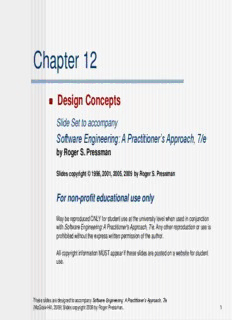
Slide Set to accompany Web Engineering: A Practitioner PDF
Preview Slide Set to accompany Web Engineering: A Practitioner
Chapter 12 Design Concepts Slide Set to accompany Software Engineering: A Practitioner’s Approach, 7/e by Roger S. Pressman Slides copyright © 1996, 2001, 2005, 2009 by Roger S. Pressman For non-profit educational use only May be reproduced ONLY for student use at the university level when used in conjunction with Software Engineering: A Practitioner's Approach, 7/e. Any other reproduction or use is prohibited without the express written permission of the author. All copyright information MUST appear if these slides are posted on a website for student use. These slides are designed to accompany Software Engineering: A Practitioner’s Approach, 7/e (McGraw-Hill, 2009) Slides copyright 2009 by Roger Pressman. 1 Design Mitch Kapor, the creator of Lotus 1-2-3, presented a “software design manifesto” in Dr. Dobbs Journal. He said: Good software design should exhibit: Firmness: A program should not have any bugs that inhibit its function. Commodity: A program should be suitable for the purposes for which it was intended. Delight: The experience of using the program should be pleasurable one. These slides are designed to accompany Software Engineering: A Practitioner’s Approach, 7/e (McGraw-Hill, 2009) Slides copyright 2009 by Roger Pressman. 2 Diversification and Convergence for Good Design [Bel81] Diversification is the acquisition of a repertoire of alternatives, the raw material of design components, component solutions, and knowledge, all contained in catalogs, textbooks, and the mind You must pick and choose elements from the repertoire that meet the requirements defined by requirements engineering and the analysis model Alternatives are considered and rejected and you converge on “one particular configuration of components, and thus the creation of the final product 3 Software Design Software design is the last software engineering action within the modeling activity and sets the stage for construction (code generation and testing). Each of the elements of the requirements model provides information that is necessary to create the four design models required for a complete specification of design. 4 Software Design from Analysis Model Data/Class design: transforms analysis classes into implementation classes and data structures Architectural design: defines relationships among the major structural elements of the software, the architectural styles and patterns Interface design – defines how software elements, hardware elements, and end-users communicate. Usage scenarios and behavioral models are used Component-level design – transforms structural elements into procedural descriptions of software components. Class-based models and behavioral models server as the basis 5 Analysis Model -> Design Model 6 Importance of Software Design: Quality Design is the place where quality is fostered in software engineering. Design provides you with representations of software that can be assessed for quality. Design is the only way that you can accurately translate stakeholder’s requirements into a finished software product or system. Without design, you risk building an unstable system—one that will fail when small changes are made; one that may be difficult to test; one whose quality cannot be assessed until late in the software process 7 Design Process Software design is an iterative process through which requirements are translated into a “blueprint” for constructing the software Initially, the blueprint depicts a holistic view of software. That is, the design is represented at a high level of abstraction— a level that can be directly traced to the specific system objective and more detailed data, functional, and behavioral requirements. As design iterations occur, subsequent refinement leads to design representations at much lower levels of abstraction. These can still be traced to requirements, but the connection is more subtle. 8 Design and Quality the design must implement all of the explicit requirements contained in the analysis model, and it must accommodate all of the implicit requirements desired by the customer. the design must be a readable, understandable guide for those who generate code and for those who test and subsequently support the software. the design should provide a complete picture of the software, addressing the data, functional, and behavioral domains from an implementation perspective. These slides are designed to accompany Software Engineering: A Practitioner’s Approach, 7/e (McGraw-Hill, 2009) Slides copyright 2009 by Roger Pressman. 9 Quality Guidelines A design should exhibit an architecture that (1) has been created using recognizable architectural styles or patterns, (2) is composed of components that exhibit good design characteristics and (3) can be implemented in an evolutionary fashion For smaller systems, design can sometimes be developed linearly. A design should be modular; that is, the software should be logically partitioned into elements or subsystems A design should contain distinct representations of data, architecture, interfaces, and components. A design should lead to data structures that are appropriate for the classes to be implemented and are drawn from recognizable data patterns. 10
Description: